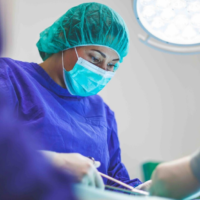Common Treatments for Severe Burn Injuries

Burn injuries can be incredibly painful and debilitating. Burn injuries happen for a variety of reasons, from cooking injuries to chemical burns. Dry heat from fires, wet heat from steam, sun, electricity, and chemicals can all cause serious burn injuries. The treatment of burn injuries can cost hundreds of thousands of dollars in medical bills. Additionally, healing from burn injuries can take months, if not years, and require multiple serious surgeries.
Under Philadelphia law, when a person’s negligence or recklessness causes another person’s injuries, the at-fault party may be liable for the burn injuries. If you have suffered a severe burn injury, you may be entitled to compensation. The lawyers at Benedum Law have the necessary experience to fight for your right to compensation. Contact our burn injury law firm today to learn how we can help you seek compensation for your injuries.
Types of Serious Burn Injuries
The first step in treating severe burn injuries is to classify the injury based on its severity. First-degree burns are the mildest burns. First-degree burns usually result in redness on the outer layer of skin and pain. Each first-degree burn is different, but many heal within a few days and do not require extensive medical treatment.
Second-degree burns go through the first layer of skin into the lower layer of skin, called the dermis. Second-degree burns cause injuries beyond redness. These burns cause swelling, blistering, redness, and pain. Third-degree burns are the most serious burns. These severe burns go through both layers of skin and affect the muscle and tissue beneath. Third-degree burns often result in charred, blackened skin. Victims of third-degree burns often cannot feel pain from the burn because the nerve endings are damaged.
Treatment of First-Degree Burns
First-degree burns are the easiest burns to treat. A key aspect of treatment includes keeping the burn clean and applying dressing to the wound. Sometimes medical providers recommend applying antibiotic ointment to the skin or aloe vera cream.
Treatment of Second-Degree Burns
Second-degree burns can damage body tissue and skin. The common treatment of second-degree burns includes rinsing the burn with cool water. Cool water can lower the temperature of the skin and stop the burn from becoming more serious. It is essential to not touch the burn with your hands as it could become infected. Many people immediately try to pop blisters that form on the skin.
The danger of popping burn blisters, however, is that dirt or germs from one’s fingers or the outside environment could cause an infection. Additionally, many people think that applying butter or spray on the burns helps the burns. Butter or sprays can trap the heat from the burn, however, and make the burn worse. Also, wrapping a burn too tightly is ill-advised since it could restrict the swelling.
Medical professionals at a medical office, urgent care, or an emergency room can evaluate the best treatment method for a second-degree burn. Usually, cleaning and dressing the wounds is enough to treat the wound. There are also many non-prescription burn dressings available in pharmacies and retail stores.
Treatment of Third-Degree Burns
The treatment of first and second-degree burns usually requires cleaning the burn and applying ointment. Third-degree burns are much more severe and can require much more intensive treatment. Since third-degree burns often burn through both layers of skin, skin grafts sometimes become a necessity. Skin-grafting is a medical procedure in which a surgeon removes skin from one area of the body and transplanting it to the burn area.
Split-Thickness Grafts for Severe Burn Injuries
Surgeons usually use split-thickness grafts when a burn victim has a large area of skin that has become burned off. In a split-thickness graft, a surgeon removes the top layer of healthy skin and part of the lower layer of skin, the dermis. The surgeon often harvests split-thickness skin from a patient’s back, buttocks, abdomen, or outer thigh. Split-thickness skin grafts are relatively new in terms of treatment options. Patients who receive skin grafts from third-degree burns often face lengthy healing processes that include physical therapy.
Split-thickness grafts are beneficial because they can minimize disfigurement caused by third-degree burns. They can also restore the skin barrier which helps prevent infection. Skin grafts also minimize tightness and contraction of the skin, allowing the burn victim to move more naturally and pain-free.
Unfortunately, when children suffer third-degree burns, they often need skin grafts. While skin grafts go a long way to help a child recover, they also come with complications. For example, skin grafts usually do not grow as quickly as natural skin. Thus, children who suffer severe burn injuries may need multiple additional surgeries over time.
Full-Thickness Skin Grafts for Severe Burn Injuries
In a full-thickness graft, the surgeon removes all of the dermis from a healthy area of skin. Since the surgeon removes all layers of skin, the area of a full-thickness skin graft is usually smaller than the area removed in a split-thickness graft. Surgeons usually remove the skin and then use staples or stitches to close the wound with a straight-line incision.
When burns are small and severe, full-thickness skin grafts are often used. The skin around full-thickness grafts usually blends in better and sometimes looks cosmetically better, as well. Undergoing skin-graft surgery is serious. The hospital staff must closely monitor a skin-graft patient after the surgery. Patients who undergo skin-graft treatment for severe burns are at serious risk of infection.
Our Severe Burn Injury Lawyers Can Help
Suffering from a moderate to severe burn injury can become a huge burden. In addition to costly medical procedures, many serious burn victims are unable to work. If another person’s negligence caused your severe burn injury, our personal injury lawyers can help. Contact our law firm today to schedule your initial consultation.